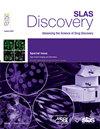新型WRN抑制剂的高通量评价
IF 2.7
4区 生物学
Q2 BIOCHEMICAL RESEARCH METHODS
引用次数: 0
摘要
DNA修复是维持基因组稳定性和预防癌症的关键组成部分。Werner综合征解旋酶(WRN)是一种参与DNA双链断裂(DSB)修复的RecQ家族解旋酶,已被确定为具有高微卫星不稳定性(MSI-H)的多种癌症类型的有希望的治疗靶点。微卫星不稳定肿瘤的特点是DNA错配修复机制的脆弱性,依赖于WRN存活。内部验证证实,crispr介导的WRN敲除在MSI-H中是致命的,但在微卫星稳定(MSS)肿瘤细胞中不是。此外,这种效应被证实取决于酶的解旋酶活性。靶向WRN的挑战在于确定有效参与解旋酶而不会对正常或微卫星稳定(MSS)细胞造成毒性的抑制剂。为了应对这一挑战,我们发起了一项合作,将体外生化分析与基于细胞的分析结合起来,使用一组MSI和MSS细胞。该方法旨在评估基于知识设计的化合物,以及通过我们的内部筛选工作确定的命中,包括基于细胞的表型筛选,自动配体识别系统(ALIS),生化ADP glo HTS和DEL。该试剂盒包括生化atp酶和解旋酶测定,以及细胞活力和两个靶标接合测定。主要功能靶标参与试验利用高含量成像方法检测DNA dsb的生物标志物,使用组蛋白H2AX磷酸化(pH2AX)。细胞热移试验作为目标接触的正交评估。这项工作实现了一种基于知识的药物发现方法,通过计算建模能力利用结构设计,产生了一系列有效的新型螺旋环WRN抑制剂,专门针对MSI-H肿瘤细胞。我们的研究结果强调了WRN作为治疗MSI-H癌症的药物靶点的潜力,并强调了跨学科方法在发现和推进新治疗药物中的重要性。本文章由计算机程序翻译,如有差异,请以英文原文为准。
High-throughput evaluation of novel WRN inhibitors
DNA repair is a critical component for the maintenance of genomic stability and cancer prevention. Werner syndrome helicase (WRN), a RecQ family helicase involved in DNA double-strand break (DSB) repair, has been identified as a promising therapeutic target for multiple cancer types with high microsatellite instability (MSI-H). Microsatelite unstable tumors are characterized by a vulnerability in the DNA mismatch repair mechanism and depend on WRN for survival. Internal validation confirmed that CRISPR-mediated knockout of WRN was lethal in MSI-H, but not microsatellite stable (MSS) tumor cells. Additionally, this effect was confirmed as contingent upon the helicase activity of the enzyme. The challenge in targeting WRN lies in identifying inhibitors that effectively engage the helicase without causing toxicity to normal or microsatellite stable (MSS) cells. To address this challenge, we initiated a collaborative effort combining in vitro biochemical assays with cell-based assays using a panel of MSI and MSS cells. This approach aimed to evaluate compounds derived from knowledge-based designs as well as hits identified through our internal screening efforts, including cell-based phenotypic screens, Automated Ligand Identification System (ALIS), biochemical ADP glo HTS, and DEL. The assay suite comprises biochemical ATPase and helicase assays, in addition to cell viability and two target engagement assays. The primary functional target engagement assay utilized a high-content imaging method to detect a biomarker of DNA DSBs, using histone H2AX phosphorylation (pH2AX). A cellular thermal shift assay served as an orthogonal assessment of target engagement. This work enabled a knowledge-based drug discovery approach that leveraged structural design through computational modeling capabilities, resulting in a potent and novel series of spirocyclic WRN inhibitors specifically targeting MSI-H tumor cells. Our findings underscore the potential of WRN as a drug target for treating MSI-H cancers and emphasize the significance of interdisciplinary approaches in the discovery and advancement of new therapeutic agents.
求助全文
通过发布文献求助,成功后即可免费获取论文全文。
去求助
来源期刊

SLAS Discovery
Chemistry-Analytical Chemistry
CiteScore
7.00
自引率
3.20%
发文量
58
审稿时长
39 days
期刊介绍:
Advancing Life Sciences R&D: SLAS Discovery reports how scientists develop and utilize novel technologies and/or approaches to provide and characterize chemical and biological tools to understand and treat human disease.
SLAS Discovery is a peer-reviewed journal that publishes scientific reports that enable and improve target validation, evaluate current drug discovery technologies, provide novel research tools, and incorporate research approaches that enhance depth of knowledge and drug discovery success.
SLAS Discovery emphasizes scientific and technical advances in target identification/validation (including chemical probes, RNA silencing, gene editing technologies); biomarker discovery; assay development; virtual, medium- or high-throughput screening (biochemical and biological, biophysical, phenotypic, toxicological, ADME); lead generation/optimization; chemical biology; and informatics (data analysis, image analysis, statistics, bio- and chemo-informatics). Review articles on target biology, new paradigms in drug discovery and advances in drug discovery technologies.
SLAS Discovery is of particular interest to those involved in analytical chemistry, applied microbiology, automation, biochemistry, bioengineering, biomedical optics, biotechnology, bioinformatics, cell biology, DNA science and technology, genetics, information technology, medicinal chemistry, molecular biology, natural products chemistry, organic chemistry, pharmacology, spectroscopy, and toxicology.
SLAS Discovery is a member of the Committee on Publication Ethics (COPE) and was published previously (1996-2016) as the Journal of Biomolecular Screening (JBS).
 求助内容:
求助内容: 应助结果提醒方式:
应助结果提醒方式:


